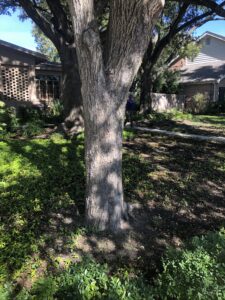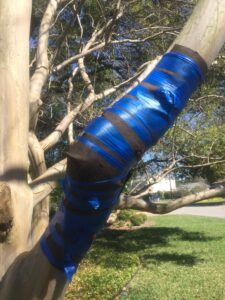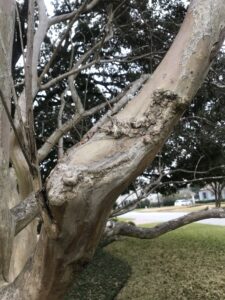The car struck the tree at more than 60 mph. The teenage driver was dead and his girlfriend was in intensive care. The car was wrapped around a tree and the car battery had gone thru a metal garage door about 25 feet from the tree. The 15 inch Cedar Elm was standing straight but had a large wound. A wrecker pulled the car from around the Elm and that doubled the size of the wound. Now we had a wound that involved 80% of the circumference of the tree and was 3 to 4 feet tall. Our client owned the tree and we got the call the next day. When they wait for the insurance appraisers, that call normally takes a week.

Elm as it looks today (2011)

Our client asked what it would cost to remove the tree and was amazed when we told her we could save it and that the wound would be covered in a year. She was more surprised when we told her it would only cost 2 hours of labor and 50 gallons of fertilizer. Folks do not expect low costs, especially when the other guys insurance is paying for everything.
The client was skeptical, but I was confident in the outcome and she decided to let us repair the tree. Maybe my guarantee to remove the tree at no cost next year if she was not happy with the outcome had a little to do with her decision. I called our production manager and that afternoon he traced some ragged bark and tacked a piece of roofing felt over the wound. We use roofing felt because it is flexible, easy to cut and, unlike black plastic, holds up for the year we want the wound covered. A few days later the tree was fertilized. That’s it, very simple. During the year after the accident, the Elm did not show any signs of stress. Our client removed the roofing felt after about 11 months. The wound was about 90% covered with normal looking bark and with normal functioning cambium under that surface callus. Dr. Dirk Dujesiefken in his ISA PodCast October 2010 states that their studies show that not only do we get normal woody tissue, normal bark, and normal cambium; we also have no discoloration and no decay under the surface callus.
I did my first car damage repair in 1980 on an Arizona Ash. I was Allan Brook’s production manager, had my BS in Forestry and my MS in Arboriculture, had never heard of such a thing, and was pretty sure that Mr. Brook was touched. Back then we covered the wound with roofing felt and sealed the edges with roofing tar or mastic, very messy. I went back every two months, removed a corner of the felt, peeked in and could not believe what I saw. After a year, the Ash had 100% coverage of the wound.

 I have since done this to about a dozen trees, mostly Live Oaks, one Pecan, one Red Oak, and have had similar results. The biggest problem is getting to the tree within 3 days, maybe 5 days of the wounding. Victims will wait on the insurance appraisers.
I have since done this to about a dozen trees, mostly Live Oaks, one Pecan, one Red Oak, and have had similar results. The biggest problem is getting to the tree within 3 days, maybe 5 days of the wounding. Victims will wait on the insurance appraisers.
I have tried this on a limb and it works as well on a limb as it does on a trunk. Most limbs that are damaged need to be removed because they are too low and will be hit again. A few years past we had a Crape Myrtle limb that was damaged by a dumpster on a construction site. We covered the wound with roofing felt and secured it with flagging ribbon. The large wound was completely covered over in less than a year.
Our BMP1 says you can use plastic or burlap to cover the wound. I like roofing felt because it is easy to work and form, it lasts a year in Texas heat, and it’s hard to see so people leave it alone. Anything that keeps the parenchyma cells moist will work. Painting the wound is not necessary and not recommended, but this procedure will work even if the wound has been painted. We paint the roofing felt to cover the roofing nails and to cover lines that are on the felt.
Take a look at the before and after pictures. This procedure works. Five years after the accident, the Elm is still looking good. One spot on top of one of the major roots did not cover and I am seeing some decay in that area that has me concerned. Give it a try the next time you are asked to be an EMT for a damaged tree and you need to perform Tree-age.
David Vaughan
Arborist
San Antonio, Texas


Recent Comments